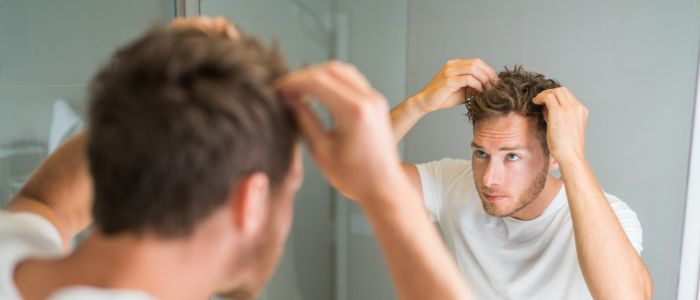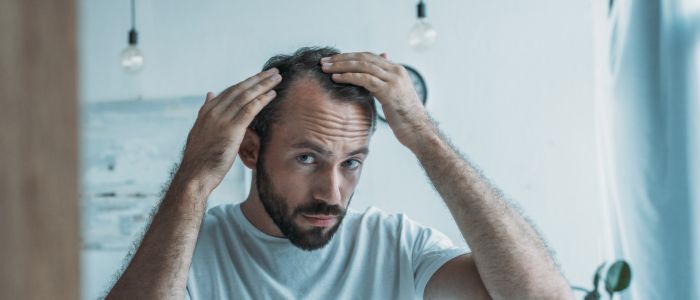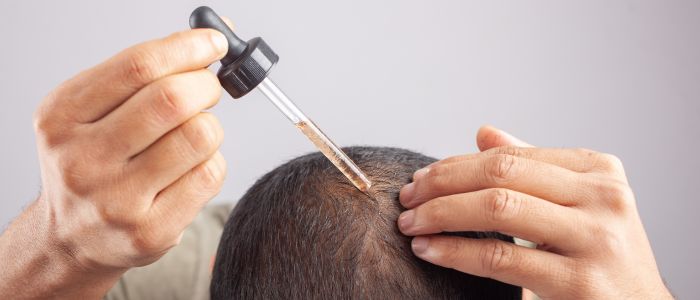
Table of Contents
- Solutions for Male/ Female Pattern Hair Loss
- Hair Growth Cycles
- Male Pattern Hair Loss
- Causes of Androgenic Alopecia in Men
- Common Concerns and Misconceptions
- Female Pattern Hair Loss
- Causes of Androgenic Alopecia in Women:
- Common Concerns and Misconceptions
- Diagnosis of Pattern Hair Loss
- Treatment Options for Male Pattern Hair Loss
- Medications for Male Pattern Hair Loss
- Treatment Options for Female Pattern Hair Loss
- Medications for Female Pattern Hair Loss
- FAQs about Male/ Female Pattern Hair Loss
- Further Reading about Procedures at Cheshire Cosmetic Surgery
Solutions for Male/ Female Pattern Hair Loss
If you’re experiencing thinning hair or receding hairlines, you should know that this is a concern that affects millions of people. Male and female pattern hair loss, also known as androgenetic alopecia, is the most common form of hair loss, affecting men and women even before the age of 50.
At Cheshire Cosmetic Surgery, Dr Dalia, a dermatologist with many years of experience, has helped countless patients understand and manage their hair loss concerns.
Hair Growth Cycles
To understand pattern hair loss, it’s crucial to first become familiar with the normal hair growth cycle. Your hair doesn’t grow continuously; instead, it goes through distinct phases:
- Anagen (Growth Phase): This is the active growth phase, lasting 2-7 years. About 85-90% of your hair is in this phase at any given time.
- Catagen (Transition Phase): A short transitional period lasting about 2-3 weeks, where hair growth stops, and the follicle shrinks.
- Telogen (Resting Phase): This phase lasts around 3 months. The hair doesn’t grow but remains attached to the follicle. About 10-15% of your hair is in this phase.
- Exogen (Shedding Phase): The old hair falls out, usually replaced by new hair entering the anagen phase.
Several factors influence this cycle, including:
- Genetics
- Age
- Nutrition
- Stress levels
- Hormones
- Overall health
In pattern hair loss, this cycle is disrupted. The anagen phase shortens progressively, while the telogen phase lengthens. Over time, the affected hair follicles produce thinner, shorter hairs, eventually leading to miniaturisation and, ultimately, dormancy of the follicle.
Male Pattern Hair Loss
Male Pattern Hair Loss, or androgenetic alopecia in men, is the most common type of hair loss, affecting up to 70% of men in their lifetime. It’s characterised by a predictable pattern of receding hairline and thinning crown.
Causes of Androgenic Alopecia in Men

The primary causes are:
- Genetics: Your family history plays a role. Contrary to popular belief, you can inherit this tendency from either parent.
- Hormones: Dihydrotestosterone (DHT), a derivative of testosterone, is the key player. In genetically susceptible men, DHT binds to hair follicles, causing them to shrink and produce thinner, shorter hairs.
MPHL usually follows a predictable pattern, known as the Norwood-Hamilton scale:
- Slight recession of the hairline, typically at the temples
- Further recession, forming an ‘M’ shape
- Thinning and hair loss on the crown (vertex)
- Progression and possible joining of the receding hairline and crown bald spot
- Extensive hair loss, leaving only a horseshoe-shaped band of hair around the sides and back of the head
It’s important to note that this progression can vary, and not all men will experience all stages.
Common Concerns and Misconceptions
- “Wearing hats causes baldness“: This is a myth. Hats don’t affect hair growth unless they’re extremely tight and cause traction alopecia.
- “Hair loss means I’m losing my masculinity“: Hair loss doesn’t define your masculinity or attractiveness. Many men embrace their changing appearance and feel confident with less hair.
- “If I’m losing hair, I should wash it less“: Regular washing is beneficial for scalp health. Infrequent washing doesn’t prevent hair loss.
- “Hair loss always skips a generation“: While genetics play a role, there’s no predictable pattern of inheritance.
- “Only older men experience hair loss“: MPHL can start as early as the late teens or early twenties.
Female Pattern Hair Loss
Female Pattern Hair Loss (FPHL), or androgenetic alopecia in women, is more common than you might think. Unlike men, women typically experience a diffuse thinning over the crown and top of the scalp, maintaining their frontal hairline.
Causes of Androgenic Alopecia in Women:
- Genetics: As with men, a family history of hair loss increases your risk.
- Hormones: While DHT plays a role, the relationship between hormones and FPHL is more complex in women. Oestrogen may have a protective effect on hair, which is why many women notice increased hair loss after menopause.
- Age: The risk of FPHL increases with age, particularly after menopause.
- Medical Conditions: Polycystic ovary syndrome (PCOS), thyroid disorders, and iron deficiency anaemia can contribute to hair loss.
- Stress: Significant physical or emotional stress can trigger or exacerbate hair loss.
FPHL usually follows the Ludwig scale:
- Type I: Minimal thinning that can be camouflaged with hair styling techniques
- Type II: Decreased volume and noticeable widening of the mid-line part
- Type III: Diffuse thinning, with a see-through appearance on the top of the scalp
Some women may also experience frontal fibrosing alopecia, a distinct pattern of hair loss that affects the front hairline.
Common Concerns and Misconceptions
- “Hair loss in women is rare“: FPHL is actually quite common, affecting millions of women worldwide.
- “It’s just a part of ageing“: While age is a factor, FPHL is a specific condition that can be treated.
- “Colouring or perming your hair causes permanent hair loss“: Normal hair treatments don’t cause permanent hair loss, though they can lead to breakage if overused.
- “Pregnancy causes permanent hair loss“: The hair loss experienced after pregnancy (postpartum telogen effluvium) is typically temporary.
- “There’s nothing you can do about female hair loss“: There are several effective treatments available for FPHL.
- “Only menopausal women experience hair loss“: FPHL can start as early as the 20s or 30s.
- “Frequent brushing stimulates hair growth“: While brushing distributes oils and can make hair look healthier, it doesn’t stimulate growth.
Many women feel particularly distressed by hair loss, as it’s often seen as less socially acceptable than in men. However, with proper diagnosis and treatment, many women can successfully manage their hair loss and maintain their confidence.
Diagnosis of Pattern Hair Loss

Recognising the signs of pattern hair loss early can improve treatment outcomes. However, you should get a proper diagnosis from your dermatologist to rule out other causes of hair loss and determine the most effective treatment plan.
When to Consult Dr Dalia
You should consider booking an appointment if you notice:
- Increased hair shedding, especially if you’re losing more than 100 hairs per day
- Thinning hair on the crown or widening of your part line
- A receding hairline or temples
- Smaller ponytail or the need for extra hair ties
- More visible scalp when styling your hair
Diagnostic Methods
During your consultation, your dermatologist may use several methods to diagnose pattern hair loss:
- Physical Examination: Your scalp and hair will be thoroughly examined. The pattern of hair loss, hair quality, and scalp condition are all important factors.
- Medical History: Your dermatologist will ask about your family history, medical conditions, medications, diet, and lifestyle factors that could contribute to hair loss.
- Pull Test: This simple test involves gently pulling on a small section of hair to see how many strands come out. It helps determine if you’re in an active phase of hair shedding.
- Trichoscopy: This non-invasive technique uses a special magnifying device (dermoscope) to examine your scalp and hair follicles in detail. It can reveal miniaturisation of hair follicles, characteristic of pattern hair loss.
- Scalp Biopsy: In some cases, a small sample of scalp skin may be taken for microscopic examination. This can help rule out other causes of hair loss and confirm the diagnosis.
- Blood Tests: These may be ordered to check for underlying conditions like thyroid disorders or nutritional deficiencies that could be contributing to your hair loss.
Ruling Out Other Causes
It’s important to note that not all hair loss is due to male or female pattern baldness. Other potential causes include:
- Telogen Effluvium: Temporary hair shedding due to stress, illness, or hormonal changes
- Alopecia Areata: An autoimmune condition causing patchy hair loss
- Traction Alopecia: Hair loss due to tight hairstyles pulling on the scalp
- Scarring Alopecia: Hair loss resulting from inflammation damaging hair follicles
- Nutritional Deficiencies: Particularly iron, vitamin D, or protein deficiencies
- Certain Medications: Some drugs can cause hair loss as a side effect
A proper diagnosis will ensure you receive the most appropriate treatment for your specific type of hair loss.
Treatment Options for Male Pattern Hair Loss
Once diagnosed with male pattern hair loss, you have treatment options available. The best approach often involves a combination of treatments tailored to your specific needs and stage of hair loss.
Medications for Male Pattern Hair Loss
Finasteride
This oral medication works by blocking the conversion of testosterone to DHT, the hormone responsible for shrinking hair follicles. It’s typically prescribed as a 1mg daily dose.
- Pros: Effective in slowing hair loss and promoting regrowth in many men
- Cons: Potential side effects including decreased libido (usually temporary)
Minoxidil

Available as an over-the-counter topical solution or foam, minoxidil is applied directly to the scalp to stimulate hair growth.
- Pros: Easy to use, can be effective for both the crown and hairline
- Cons: Must be used consistently for continued results
Hair Transplantation
For men with significant hair loss, hair transplantation can provide dramatic, permanent results. Modern techniques like Follicular Unit Extraction (FUE) and Follicular Unit Transplantation (FUT) can create natural-looking results.
- Pros: Permanent solution, natural-looking results
- Cons: Expensive, requires a skilled surgeon, may need multiple sessions
Scalp Micropigmentation
This cosmetic procedure involves tattooing pigment into the scalp to create the appearance of a fuller head of hair or a closely-shaved look.
- Pros: Immediate results, low maintenance
- Cons: Not suitable for everyone, requires touch-ups over time
Lifestyle Changes and Supplements
While not primary treatments, certain lifestyle changes and supplements may support overall hair health:
- Balanced diet rich in proteins, vitamins, and minerals
- Stress management techniques
- Gentle hair care practices
- Supplements like biotin, saw palmetto, or specific hair growth vitamins (consult your dermatologist before starting any new supplements)
Treatment Options for Female Pattern Hair Loss
Female pattern hair loss can be particularly distressing, but there are several effective treatment options available. As with men, a combination approach often yields the best results.
Medications for Female Pattern Hair Loss
Minoxidil
This is the only medication approved by the FDA for female pattern hair loss. It’s available over-the-counter as a 2% or 5% solution or foam.
- Pros: Non-invasive, can be effective in slowing hair loss and promoting regrowth
- Cons: Must be used indefinitely to maintain results, may cause initial shedding
Anti-androgens
In some cases, especially if there’s evidence of excess androgens, medications like spironolactone may be prescribed.
- Pros: Can be effective for women with hormonal imbalances
- Cons: Potential side effects, not suitable for women planning pregnancy
Platelet-Rich Plasma (PRP) Therapy
This treatment involves injecting a concentration of your own platelets into your scalp to stimulate hair growth.
- Pros: Uses your own blood components, minimal side effects
- Cons: Requires multiple sessions, results can vary
Hair Transplantation Considerations for Women
While hair transplantation can be effective for women, it’s not always the best option due to the diffuse nature of female pattern hair loss. However, for suitable candidates, it can provide good results.
- Pros: Permanent solution, natural-looking results
- Cons: Limited donor hair available due to diffuse thinning, may not be suitable for all women
FAQs about Male/ Female Pattern Hair Loss

Can certain hairstyles or hair products accelerate this condition?
While hairstyles and products don’t cause pattern hair loss, some practices can exacerbate the issue. Tight hairstyles that pull on the hair (like tight ponytails or cornrows) can cause traction alopecia, which may worsen the appearance of pattern hair loss. Heavy use of heat styling tools or harsh chemical treatments can damage the hair shaft, making thinning more noticeable. It’s best to opt for gentle styling practices and use heat protectants when styling.
Is it true that pattern hair loss can skip generations?
The genetics of pattern hair loss are complex and don’t follow a simple inheritance pattern. While it’s possible for hair loss to appear to “skip” a generation, this is often due to the interplay of multiple genes from both maternal and paternal sides. Someone might inherit hair loss genes but not express them due to other genetic or environmental factors. Therefore, even if your parents don’t have noticeable hair loss, you could still be at risk if it runs in your extended family.
Can stress cause pattern hair loss?
Stress itself doesn’t cause androgenetic alopecia (pattern hair loss). However, severe stress can trigger a type of temporary hair loss called telogen effluvium, which can make pattern hair loss appear worse or become noticeable earlier. Chronic stress may also potentially exacerbate pattern hair loss by affecting hormone levels and overall health. Managing stress through lifestyle changes and relaxation techniques can be beneficial for your overall hair health.
Are there any dietary changes that can help with pattern hair loss?
While diet alone can’t prevent or cure pattern hair loss, certain nutritional deficiencies can worsen hair thinning. Ensuring a balanced diet rich in proteins, iron, vitamins (especially B vitamins and vitamin D), and minerals like zinc can support overall hair health. Some studies suggest that a Mediterranean-style diet, which is rich in raw vegetables and fresh herbs, may have a protective effect against androgenetic alopecia. However, it’s important to note that dietary changes should complement, not replace, medical treatments for pattern hair loss.
Can pattern hair loss affect body hair as well?
Interestingly, while pattern hair loss affects the scalp, it generally doesn’t impact body hair. In fact, men with male pattern baldness often maintain or even experience increased growth of body hair. This is because different types of hair follicles respond differently to androgens (male hormones). Scalp hair follicles in people with pattern hair loss are sensitive to DHT and shrink in its presence, while body hair follicles are often stimulated by androgens. This is why some men may experience thinning scalp hair but increased chest or facial hair growth.
Medical References for Male/ Female Pattern Hair Loss
- Androgenetic alopecia: MedlinePlus Genetics: https://medlineplus.gov/genetics/condition/androgenetic-alopecia/
- Treating female pattern hair loss: https://www.aad.org/public/diseases/hair-loss/types/female-pattern
- Male Pattern Baldness (Androgenic Alopecia): https://my.clevelandclinic.org/health/diseases/24515-male-pattern-baldness-androgenic-alopecia
- Treatment options for androgenetic alopecia: Efficacy, side effects and more: https://pubmed.ncbi.nlm.nih.gov/32114540/
- Androgenetic Alopecia Treatment & Management: https://emedicine.medscape.com/article/1070167-treatment
Further Reading about Procedures at Cheshire Cosmetic Surgery
-
- Read more about Causes and Treatment for Alopecia Areata
- Read more about Causes and Treatment for Hyperhidrosis (Excessive Sweating)
- Read more about Hair Loss Treatments
- Read more about Causes and Treatment for Psoriasis
- Read more about What to Expect During and After an Excision Biopsy for Suspected Skin Cancer
- Read more about Causes and Treatment for Scarring Hair Loss
Back to blog






